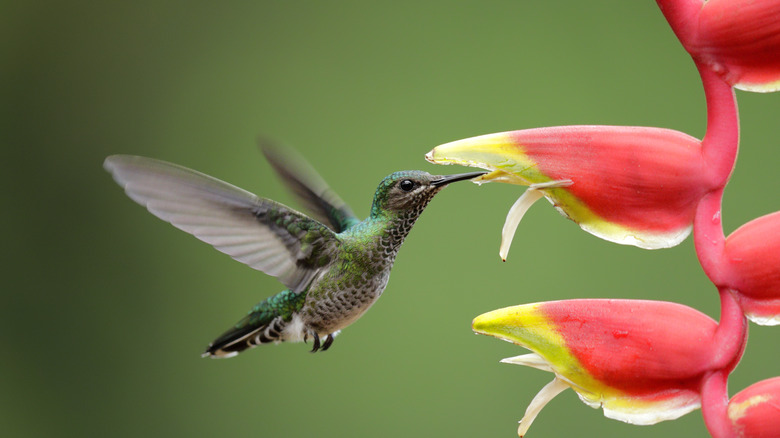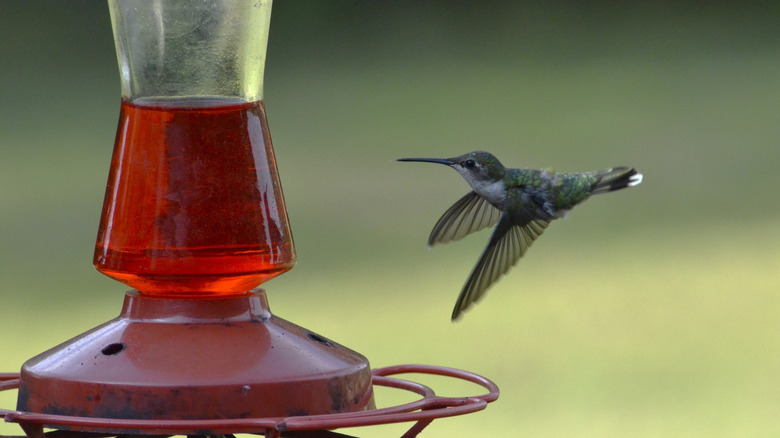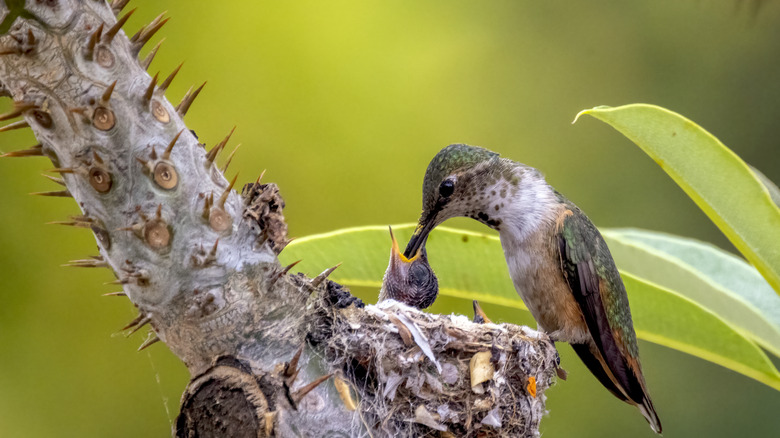How To Make Your Yard Safe Enough To Attract Nesting Hummingbirds
If you have a hummingbird that can't seem to stay away from your garden, you may be on the hunt for ways to make them stay just a bit longer. Whether you're an avid bird lover or in the process of creating the perfect pollinator-friendly garden, it only takes a few steps to create a safe nesting space for your local hummingbirds. These small, fast-moving creatures will need more than just nectar before they decide on a home. While they can be extremely particular about where they raise their young, making it difficult to predict if and when they might choose your garden, there are a few changes that you can make to your outdoor spaces that will provide a safe breeding ground for local hummingbirds.
One of the most important hurdles for hummingbird nesting is eliminating the amount of interaction that you or your pets may have with them. Hummingbirds tend to stay away from animals that they perceive as predators, including your furry friends. If they see signs of these predators around your yard, they will most likely deem it an unsafe area and not choose to nest in that location. If you notice that you have a particularly active backyard, you may want to place feeders and nesting materials in the front for a quieter environment. The same applies to loud outdoor activities that you may participate in around your home. For example, a rambunctious basketball hoop in your driveway can be excellent for kids, but it won't make hummingbirds feel safe to raise their young. Instead, you'll want to place supplies like food and water in more secluded areas of your yard, whether it's a small garden or a wooded area, as this can further encourage nesting.
The right necessities for hummingbirds
While shelter is essential for creating a safe nesting area for hummingbirds, your garden must also deliver a secure supply of necessities for these small birds, specifically water and food sources. Hummingbirds typically avoid traditional bird baths, as they tend to be too deep. To provide them with access to water, try setting out a gentle mister or fountain as a safe source of clean source of water. The water source should also be fairly quiet, and if you can, try tucking it amongst some greenery to add an additional sense of security for the hummingbirds. Avoid using any dyes in your nectar, sticking to a 4:1 water-to-sugar ratio to keep it safe for hummingbird consumption. Refresh the mix every few days or as you see it start to run out.
Food is another major concern for hummingbirds, as they require a safe, reliable source when deciding to nest. Native plants are an excellent way to attract birds, providing necessary food sources for your hummingbirds in the form of rich nectar and small insects. Group vibrant colorful flowers together that bloom at different points in the year to provide a buffet of food sources. You should also avoid using insecticides or harsh pest control methods around your garden, as these may be harmful to the insects and hummingbirds.When placing feeders around your yard, either traditional seeds or nectar feeders, you'll want to spread them out fairly evenly. If they are too close together, it will increase competition for food and discourage hummingbirds from nesting. You can place one in the front yard and one in the back to provide a safe food source for your hummingbirds and avoid overcrowding.
Providing safe nesting sites and materials
In terms of location, hummingbirds prefer to build their nests anywhere between 10 to 40 feet off the ground. They usually place them in sheltered areas of trees that provide sufficient cover from predators. Good candidates include mature trees and dense shrubs. You'll want to avoid over pruning these prime real estate locations for your hummingbirds, as these will provide secure areas for building their homes. Creating a hummingbird-safe garden doesn't require planting additional shrubs, merely letting nature take it's course to provide the right nesting area for your avian friends. While you can encourage them to nest around your garden, hummingbird nests can be hard to spot and you may not be able to see their hiding spot right away.
When it comes to nesting, hummingbirds can be surprisingly crafty, building small camouflaged nests out of various natural materials that are available in the region. Female hummingbirds do all the work when it comes to nest building, and they tend to rely on specific materials to build their homes. Soft plant fibers, moss, spider silk, and even cotton can make excellent nest building materials that may draw hummingbirds to your yard. You'll want to avoid a number of artificial materials that a hummingbird may mistake while nest building, including synthetic fabrics, dryer lint, and pet hair. The chemicals that can be found on these materials, like fabric softener or tick treatment, can be harmful to newborn hummingbirds, making the entire nest unsafe. Leave safe materials in elevated spots where a hummingbird can easily access them — typically in a elevated area away from predators


